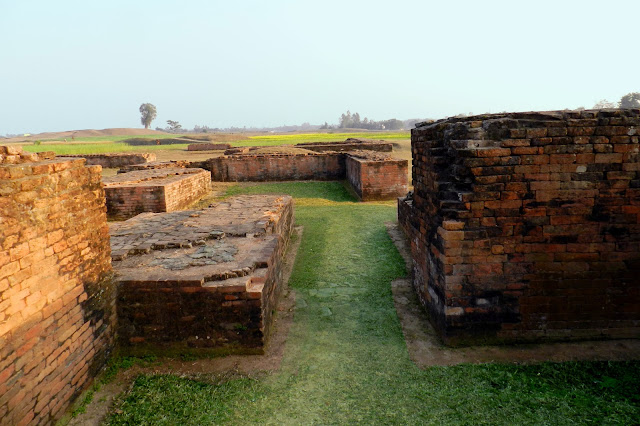http://www.gaudiyanritya.org/ Gaudiya Nritya -A classical Bengali school of Indian classical dance.
THE CLASSICAL TEXT ON INDIAN DRAMATURGY, THE NATYASHASTRA OF BHARATA, DOES NOT MENTION ANY OF THE CLASSICAL DANCE FORMS RECOGNIZED TODAY, BUT IN IT’S FOURTEENTH CHAPTER ARE THE FOUR PRAVITTIS: DAKSHINATYA, AUDRAMAGADHI, AVANTI AND PUNCHALI.
This piece named ARDHANARISVARA after the mythical Androgynous incarnation of Lord Shiva and Godess Parvati blended into one. This dance piece is to be played at the Balurghat Bookfair on 11.1.14. Modern day Personality theory extols Androgynous personality as the most balanced and modern form. ARCHEOLOGICAL SITES IN the DISTRICT  | ||
| REMAINS OF BANGARH
BANGARH
Historically probably the most important of all places in the entire district, Bangarh boasts of the largest share of archaeological ruins and icons to be found in Dakshin Dinajpur. It is situated 45 Km away from Balurghat town and about 65 Km from Malda town. Bangarh was the capital of KOTI BARSHA district. During the GUPTA period, the whole of North Bengal was known as PUNDRA VARDHANA BHUKTI (PRADESH).
It was again sub-divided into number of VISHAYAs (DISTRICT). KOTI BARSHA was one of the districts. Its old name was DEVKOTE/DEVIKOTE. In a radius of 8 Km of this area, different ancient archaelogical remnants have been found. Under the leadership of Prof Kunja Gobinda Goswami the excavation work was done between 1938-I941. After excavation, so many historical objects and archeological ruins have been found beginning from Mauryan era to Muslim period.
SHRINE OF ATA SHAH
The famous Sufi shrine under which lies the tomb of the great Sufi saint, Moulana Atauddin Shah. After the invasion of Turkish General, Ikhtiyar Ud-din Muhammad Bin Bakhtiyar Khalji in Devkot (present Gangarampur)many sufi saints came and established shelters. Out of them the most ancient and the most influential was Ata Shah. Towards the end of the 13th century the Sufi saint established here near the bank of Dhal dighi.
INTERNATIONAL BORDER AT HILLI
It was 1947. We got freedom at the cost of partition. India was divided and so was the town Hilli. The east of Hilli formed a part of Pakistan (present Bangladesh) and the west of Hilli was attached to India. Today Hilli is an exceptional international border compared to other borders because it has a railway station so adjacent. The communication of Hilli on both sides is well developed. An immigration check post office had been opened near the border. Hundreds of trucks and lorries with different commodities enter bangladesh through this border for export business.
|
 |
| BALURGHAT 1947 |
India got her much awaited freedom on 15th August 1947. But according to the new map of India, Balurghat was included in Pakistan. It took 3 days to correct the error filled map. And for the three days the Pakistani flag was flown over Balurghat-Boys-High-School building. Atlast Balurghat became a part of India on 18th August 1947. The contemporary district magistrate Mr. Bipul Kumar Acharya, I.A.S. (the first district Magistrate of West Dinajpur) hoisted the tricolor before the administrative office building. On the same day the district of West Dinajpur, with administrative headquarter at Balurghat, was officially formed. At the independence-celebration gathering at Balurghat Boys’ High School playground, the freedom-fighters Saroj Ranjan Chattopadhyay and Sailen Das appeared before the public disclosing their hidden identity.
Mahipaldighi- Neelkuthi
Stupa at Nazirpur
Manmatha Ray, a bengali dramatist represented more truly than anyone else the transition in Bengal literature. His first full length work, Chandsaudagar in 1927 was based on a bengali legend, full of dramatic material. Also same is noticeable in many subsequent dramatizations of stories from the Hindu epics, Puranas, and Indian mythology. He wrote Ashoka in 1933 and Mir Qasim in 1938. He is considered as the father of one-act plays of bengal. Fortunately he came to Balurghat after receiving his L.L.B. degree in 1925 and started practicing law. His house "BARDA BHAWAN" can still be seen. An art gallery and a drama cultivation centre has been opened in his name.
Indologist and Researcher Sri Debabrata Malakar puts forward his views. Let the world decide.
Terracota temple at Khanpur, near Balurghat under the process of being declared as a heritage site.
 |
| MONOHALI ZAMINDAR HOUSE |
















Very good. Let this page grow. Contributors are welcome.
ReplyDeleteReally fantastic.
DeleteCan anybody here shed light on the Jagdalla mahavihar, the institution where Atish Dipankar, Advay vajra and other Vajrayani Buddhists belonged?
ReplyDeleteGaudiya Nritya -A classical Bengali school of Indian classical dance.
ReplyDelete